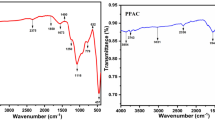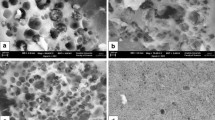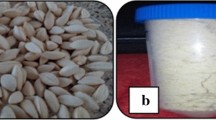Abstract
Cadmium(II) adsorption was investigated on different adsorbents, namely Lycopersicon esculentum peel (LEP), Lycopersicon esculentum peel activated carbon (LEP-AC), Brassica botrytis leaves (BBL) and Brassica botrytis leaves activated carbon (BBL-AC). Batch experiments were performed to study the effects of pH, temperature, initial metal ion concentration, contact time and adsorbent dosage. The study concluded that the incorporation of activated carbon to the parental adsorbents leads to accelerate the rate of adsorption. The process was exothermic and due to the exothermic nature, the percent adsorption was decreased by increasing temperature. The experimental data were evaluated by Lagergren and Ho’s kinetic models by taking into account the adsorption of Cd by different adsorbents.








Similar content being viewed by others
References
Chirila E, Draghici C (2011) Analytical approaches for sampling and sample preparation for heavy metals analysis in biological materials. Springer, Dordrecht, pp 129–143
Diez N, Alvarez P, Granda M, Blanco C, Gryglewicz G, Wróbel-Iwaniec I, Śliwak A, Machnikowski J, Menendez R (2014) Tailoring micro-mesoporosity in activated carbon fibers to enhance SO2 catalytic oxidation. J Colloid Interface Sci 428:36–40
Din IU, Shaharun MS, Subbarao D, Naeem A (2014) Physicochemical investigations of carbon nanofiber supported Cu/ZrO2 catalyst, In: AIP conference proceedings, American Institute of Physics, 2014, pp 549–554
Din IU, Tasleem S, Naeem A, Shaharun MS, Nasir Q (2016) Study of annealing conditions on particle size of nickel ferrite nanoparticles synthesized by wet chemical route. Synth React Inorg Met-Org, Nano-Met Chem 46:405–408
Din IU, Shaharun MS, Naeem A, Alotaibi MA, Alharthi AI, Nasir Q (2020a) Effect of reaction conditions on the activity of novel carbon nanofiber-based Cu/ZrO2 catalysts for CO2 hydrogenation to methanol. C R Chim 23:57–61
Din IU, Tasleem S, Mubashir M, Bakht MA (2020b) Antimicrobial activity of antibiotic doped carbon nanoparticles extracted from kitchen soot against pathogenic Gram-negative bacteria. J Pharm Res Int 32:1–8
Din IU, Alotaibi MA, Alharthi AI (2020c) Green synthesis of methanol over zeolite based Cu nano-catalysts, effect of Mg promoter. Sustain Chem Pharm 16:100264
Dziubanek G, Piekut A, Rusin M, Baranowska R, Hajok I (2015) Contamination of food crops grown on soils with elevated heavy metals content. Ecotoxicol Environ Saf 118:183–189
El-Sayed GO, Dessouki HA, Ibrahim SS (2010) Biosorption of Ni(II) and Cd(II) ions from aqueous solutions onto rice straw. Chem Sci J 9:1
Halaimi F, Kellali Y, Couderchet M, Semsari S (2014) Comparison of biosorption and phytoremediation of cadmium and methyl parathion, a case-study with live Lemna gibba and Lemna gibba powder. Ecotoxicol Environ Saf 105:112–120
Iqbal M, Saeed A, Akhtar N (2002) Petiolar felt-sheath of palm: a new biosorbent for the removal of heavy metals from contaminated water. Bioresour Technol 81:151–153
Kocaoba S (2007) Comparison of Amberlite IR 120 and dolomite’s performances for removal of heavy metals. J Hazard Mater 147:488–496
Kocaoba S, Akcin G (2005) Removal of chromium(III) and cadmium(II) from aqueous solutions. Desalination 180:151–156
Ku Y, Wu M-H, Shen Y-S (2002) A study on the cadmium removal from aqueous solutions by zinc cementation. Sep Sci Technol 37:571–590
Kuganathan N, Anurakavan S, Abiman P, Iyngaran P, Gkanas EI, Chroneos A (2021) Adsorption of lead on the surfaces of pristine and B, Si and N-doped graphene. Phys B Condens Matter 600:412639
Lee C-H, Truc NTT, Lee B-K, Mitoma Y, Mallampati SR (2015) Evaluation of heavy metals in hazardous automobile shredder residue thermal residue and immobilization with novel nano-size calcium dispersed reagent. J Hazard Mater 296:239–247
Lin X, Burns RC, Lawrance GA (2005) Heavy metals in wastewater: the effect of electrolyte composition on the precipitation of cadmium(II) using lime and magnesia. Water Air Soil Pollut 165:131–152
Mortaheb HR, Kosuge H, Mokhtarani B, Amini MH, Banihashemi HR (2009) Study on removal of cadmium from wastewater by emulsion liquid membrane. J Hazard Mater 165:630–636
Moussout H, Ahlafi H, Aazza M, Maghat H (2018) Critical of linear and nonlinear equations of pseudo-first order and pseudo-second order kinetic models. Karbala Int J Mod Sci 4:244–254
Naeem A, Din IU, Saeed T, Alotaibi MA, Alharthi AI, Habib A, Malik T (2020) Synthesis, characterization and adsorption studies of h-BN crystal for efficient removal of Cd2+ from aqueous solution. Ceram Int 47:4749
Najim TS, Elais NJ, Dawood AA (2009) Adsorption of copper and iron using low cost material as adsorbent. E-J Chem 6:682568
Nasrullah A, Khan AS, Bhat A, Din IU, Inayat A, Muhammad N, Bakhsh EM, Khan SB (2020) Effect of short time ball milling on physicochemical and adsorption performance of activated carbon prepared from Mangosteen peel waste. Renew Energy 168:723
Naushad M, Mittal A, Rathore M, Gupta V (2015) Ion-exchange kinetic studies for Cd(II), Co(II), Cu(II), and Pb(II) metal ions over a composite cation exchanger. Desalination Water Treat 54:2883–2890
Padmavathy KS, Madhu G, Haseena PV (2016) A study on effects of pH, adsorbent dosage, time, initial concentration and adsorption isotherm study for the removal of hexavalent chromium (Cr(VI)) from wastewater by magnetite nanoparticles. Proced Technol 24:585–594
Qaiser S, Saleemi AR, Mahmood Ahmad M (2007) Heavy metal uptake by agro based waste materials. Electron J Biotechnol 10:409–416
Qin P, Wang H, Yang X, He L, Müller K, Shaheen SM, Xu S, Rinklebe J, Tsang DC, Ok YS (2018) Bamboo-and pig-derived biochars reduce leaching losses of dibutyl phthalate, cadmium, and lead from co-contaminated soils. Chemosphere 198:450–459
Rambabu K, Thanigaivelan A, Bharath G, Sivarajasekar N, Banat F, Show PL (2020) Biosorption potential of Phoenix dactylifera coir wastes for toxic hexavalent chromium sequestration. Chemosphere 268:128809
Rao K, Mohapatra M, Anand S, Venkateswarlu P (2010) Review on cadmium removal from aqueous solutions. Int J Eng Sci Technol 2:81–103
Saeed T, Naeem A, Din IU, Alotaibi MA, Alharthi AI, Khan IW, Khan NH, Malik T (2020) Structure, nomenclature and viable synthesis of micro/nanoscale metal organic frameworks and their remarkable applications in adsorption of organic pollutants. Microchem J 159:105579
Sen TK, Sarzali MV (2008) Removal of cadmium metal ion (Cd2+) from its aqueous solution by aluminium oxide (Al2O3): a kinetic and equilibrium study. Chem Eng J 142:256–262
Sharma G, Naushad M (2020) Adsorptive removal of noxious cadmium ions from aqueous medium using activated carbon/zirconium oxide composite: isotherm and kinetic modelling. J Mol Liq 30:113025
Sharma G, Pathania D, Naushad M, Kothiyal N (2014) Fabrication, characterization and antimicrobial activity of polyaniline Th(IV) tungstomolybdophosphate nanocomposite material: efficient removal of toxic metal ions from water. Chem Eng J 251:413–421
Sulaiman SY, Ra’ba’ah SA, Ismail I, Man HC, Rosdi NU (2021) Rapid adsorption of magnetite nanoparticles from recycled mill scale waste as potential adsorbent for removal of Cu(II) ions. Solid State Phenom 317:271
Varsha Mudgal NM, Anurag Mudgal RB, Singh SM (2010) Effects of toxic metals on human health. Open Nutr J 3:94–99
Wei P, Lou H, Xu X, Xu W, Yang H, Zhang W, Zhang Y (2021) Preparation of PP non-woven fabric with good heavy metal adsorption performance via plasma modification and graft polymerization. Appl Surf Sci 539:148195
Xu G, Yang X, Spinosa L (2015) Development of sludge-based adsorbents: preparation, characterization, utilization and its feasibility assessment. J Environ Manag 151:221–232
Yadanaparthi SKR, Graybill D, von Wandruszka R (2009) Adsorbents for the removal of arsenic, cadmium, and lead from contaminated waters. J Hazard Mater 171:1–15
Zhu C, Tian H, Cheng K, Liu K, Wang K, Hua S, Gao J, Zhou J (2016) Potentials of whole process control of heavy metals emissions from coal-fired power plants in China. J Clean Prod 114:343–351
Acknowledgements
The financial support provided by the Deanship of Scientific Research at Prince Sattam bin Abdulaziz University, Alkharj, Saudi Arabia is acknowledged. The research facilities provided by the chemistry department, college of science and humanities, Prince Sattam bin Abdulaziz University are also acknowledged.
Author information
Authors and Affiliations
Corresponding author
Ethics declarations
Conflict of interest
The authors declare that they have no known competing financial interests or personal relationships that could have appeared to influence the work reported in this paper.
Additional information
Editorial responsibility: Gaurav Sharma.
Rights and permissions
About this article
Cite this article
Shah, Q.U., Tasleem, S., Naeem, A. et al. Reporting the application of Lycopersicon esculentum peel and Brassica botrytis leaves as adsorbents for Cd removal from aqueous solution. Int. J. Environ. Sci. Technol. 19, 1937–1944 (2022). https://doi.org/10.1007/s13762-021-03244-y
Received:
Revised:
Accepted:
Published:
Issue Date:
DOI: https://doi.org/10.1007/s13762-021-03244-y




